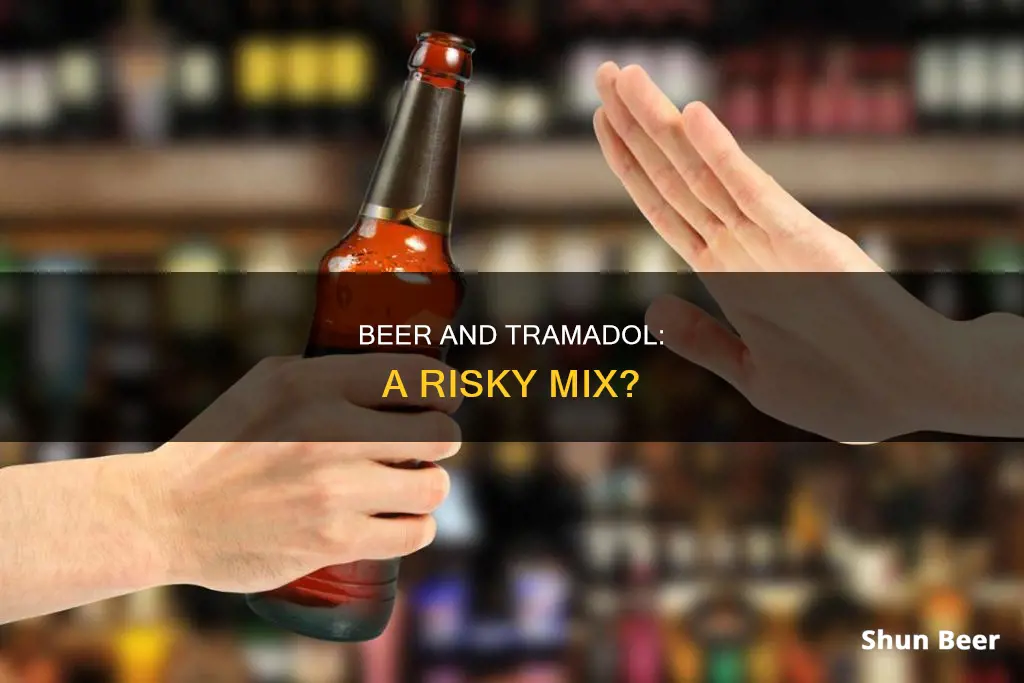
Drinking beer and taking tramadol is not recommended as both are central nervous system depressants, which means they slow down brain function and can lead to a fatal overdose. Mixing the two can cause a range of side effects, including drowsiness, dizziness, lowered blood pressure, decreased heart rate, poor decision-making, loss of consciousness, seizures, respiratory depression, hypothermia, hypertension, kidney damage, and stroke. In severe cases, this combination can lead to a coma or death.
| Characteristics | Values |
|---|---|
| Should you drink beer on tramadol? | No |
| Why? | Both are central nervous system depressants, which can lead to a fatal overdose |
| Both can cause respiratory depression (shallow or infrequent breathing) | |
| The combination can lead to unconsciousness, coma, respiratory arrest, or death | |
| The combination increases the risk of psychosis, anxiety, delusions, mania, paranoia, and addiction | |
| Tramadol has a long-lasting effect on the body, and can be addictive | |
| Alcohol can give a false sense of security, leading to overconsumption of both substances |
What You'll Learn
- Tramadol and alcohol are central nervous system depressants, which can slow down brain function
- Mixing the two can lead to a fatal overdose
- Side effects of mixing the two include problems with concentration, cognitive impairment, poor judgement, and coordination difficulties
- Tramadol and alcohol can increase the risk of psychosis, anxiety, delusions, mania, and paranoia
- Tramadol is an opioid that is frequently prescribed for moderate to severe pain

Tramadol and alcohol are central nervous system depressants, which can slow down brain function
Tramadol is an opioid pain medication prescribed to treat moderate to severe pain. It is also used to treat chronic pain when weaker pain relievers are no longer effective. It works by blocking pain signals that travel along nerves to the brain.
Alcohol is a substance that depresses the central nervous system. When consumed, it can slow down brain function and cause respiratory depression, or shallow or infrequent breathing.
Tramadol is also a central nervous system depressant. This means that when tramadol and alcohol are used together, they can interact and lead to increased side effects. These side effects may include problems concentrating, cognitive impairment, problems with judgment, and coordination difficulties. The combination of these two substances can also increase the risk of psychosis, anxiety, delusions, mania, paranoia, and serotonin syndrome.
In addition, mixing tramadol and alcohol can lead to severe oxygen deprivation and long-term brain damage. It can also cause respiratory problems, including respiratory arrest, slowed or stopped breathing, and even coma. This is because both substances have additive effects on the central nervous system, intensifying the sedative and respiratory depressing effects of both. As a result, the combination of tramadol and alcohol can lead to unconsciousness, overdose, or death.
Furthermore, the risk of a fatal overdose is also increased when tramadol is used with other central nervous system depressants. This includes other opioids, benzodiazepines, or street drugs. It is important to note that even a single tablet of tramadol combined with alcohol can be dangerous. Therefore, it is safest to avoid consuming alcohol while taking tramadol to prevent any potential harmful interactions and lower the risk of overdose.
COVID and Beer: Is Drinking Safe?
You may want to see also

Mixing the two can lead to a fatal overdose
Tramadol is an opioid pain medication that interacts with certain nerve receptors in the brain to block pain signals. It is often prescribed to treat moderate to severe pain, as well as chronic pain when weaker pain relievers are ineffective. While it has a relatively low potential for dependence compared to other opioids like morphine, it can still be addictive when used for prolonged periods.
Mixing tramadol with alcohol can lead to a fatal overdose. Both substances are central nervous system depressants, which means they can slow down brain function when combined. This can lead to a range of dangerous side effects, including:
- Extreme sedation
- Respiratory depression (slowed or stopped breathing)
- Increased heart rate
- Loss of muscle control
- Poor coordination
- Cognitive impairment
- Problems with judgment
- Coma
- Death
The combination of tramadol and alcohol can also increase the risk of psychosis, anxiety, delusions, mania, paranoia, and serotonin syndrome. The severity of these side effects typically depends on the amount of alcohol consumed and the dosage of tramadol. Additionally, the risk of a fatal overdose is also increased when tramadol is used with other central nervous system depressants, such as benzodiazepines or street drugs.
It is important to note that even a single tablet of tramadol combined with alcohol can be dangerous. Therefore, it is strongly advised not to mix tramadol and alcohol under any circumstances. If you are unsure if you are taking a central nervous system depressant, consult your doctor or pharmacist before taking tramadol.
Beer and Meloxicam: Safe or Not?
You may want to see also

Side effects of mixing the two include problems with concentration, cognitive impairment, poor judgement, and coordination difficulties
Mixing tramadol and alcohol can have serious consequences, including problems with concentration, cognitive impairment, poor judgement, and coordination difficulties. Both substances are central nervous system depressants, which means they can slow down brain function when combined. This can lead to a range of side effects, including problems with concentration and cognitive impairment.
When it comes to concentration, individuals may find it difficult to focus and may experience brain fog. This can impact their ability to perform tasks that require sustained attention, such as driving or operating machinery. Cognitive impairment can also occur, leading to issues with memory, decision-making, and problem-solving.
Additionally, the combination of tramadol and alcohol can result in poor judgement. Individuals may make impulsive decisions or struggle to assess risks accurately. This can lead to dangerous behaviours, such as engaging in risky activities or neglecting important responsibilities.
Coordination difficulties are also a common side effect of mixing tramadol and alcohol. This can manifest as clumsiness, unsteadiness, or slowed reactions. Individuals may find it challenging to perform tasks that require fine motor skills or complex movements.
It is important to note that the severity of these side effects can vary depending on factors such as the dosage of tramadol, the amount of alcohol consumed, and individual differences in metabolism and tolerance. However, given the potential risks, it is generally advised to avoid mixing tramadol and alcohol. If individuals have concerns or questions about their specific situation, they should consult a medical professional for personalised advice.
Beer's Anti-Inflammatory Benefits: Fact or Fiction?
You may want to see also

Tramadol and alcohol can increase the risk of psychosis, anxiety, delusions, mania, and paranoia
Tramadol is an opioid that is often prescribed to treat moderate to severe pain. It works by blocking pain signals that travel to the brain via nerves. While it has a low potential for dependence compared to other opioids like morphine, it can still be addictive when used for a long time.
Alcohol and tramadol are a dangerous combination because they are both central nervous system depressants. This means that they can slow down brain function when combined, increasing the risk of a fatal overdose. The combination can also lead to psychosis, anxiety, delusions, mania, and paranoia.
When mixed, alcohol and tramadol can intensify the sedative and respiratory depressing effects of both substances, leading to unconsciousness, coma, respiratory arrest, and even death. Tramadol also increases the risk of serotonin syndrome, which can cause agitation, confusion, abnormal eye movements, fever, diarrhea, muscle spasms, shivering, and tremors.
The severity of these side effects depends on the amount of alcohol consumed and the dosage of tramadol. It is recommended to wait until the tramadol is completely out of your system before consuming alcohol. For short-acting tramadol, this means waiting about 32 hours, while for long-acting tramadol, it takes about 50 hours.
If you suspect an overdose, seek emergency medical treatment immediately. Signs of a tramadol overdose include increased heart rate, excessive sleepiness, and loss of muscle control.
Beer and Anemia: What's the Safe Limit?
You may want to see also

Tramadol is an opioid that is frequently prescribed for moderate to severe pain
Tramadol is a synthetic opioid that was introduced in the US in the mid-90s. It is a Schedule IV controlled substance with a low to moderate potential for dependence, especially when compared to other opioids like morphine. However, addiction can still occur with prolonged use. As with all opioids, it is important to take tramadol only as directed by a licensed medical professional.
Tramadol has side effects, including nausea, dizziness, vomiting, constipation, headache, and dry mouth. When taken with alcohol, these side effects may be exacerbated, leading to problems with concentration, cognitive impairment, judgment, and coordination. The combination of tramadol and alcohol can also result in a dangerous increase in blood pressure and a false sense of security, leading to overconsumption of either substance.
The most serious risk of mixing tramadol and alcohol is the potential for a deadly overdose on either substance. Both substances are central nervous system depressants, which means they can slow down brain function and cause respiratory depression when combined. This can lead to excessive sedation, slowed breathing, coma, and even death. Therefore, it is safest to avoid consuming alcohol while taking tramadol and to consult a doctor about when it is safe to drink after taking a dose.
Ash Wednesday Beer: Is It Allowed?
You may want to see also
Frequently asked questions
No, it is not safe to drink alcohol while taking tramadol. Both substances are central nervous system depressants, which means they can slow down brain function when combined. This can lead to unconsciousness, coma, respiratory arrest, overdose, or death.
The primary risk of drinking beer while taking tramadol is worsened central nervous system depressant side effects, including excessive sedation, slowed breathing, and in severe cases, coma and death.
The common side effects of mixing tramadol and alcohol include drowsiness or dizziness, reduced coordination, lowered blood pressure, decreased heart rate, poor decision-making, and loss of consciousness.
It is safest to wait until the tramadol is completely out of your system before drinking beer. Short-acting tramadol has a half-life of around 6.3 hours, so it takes around 32 hours to fully leave your system. Long-acting tramadol has a half-life of around 10 hours, so it takes about 50 hours to fully leave your system.
If you suspect someone is overdosing on tramadol or alcohol, seek emergency medical treatment immediately. While waiting for help to arrive, try to keep the person awake and monitor their breathing.







